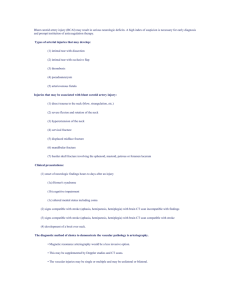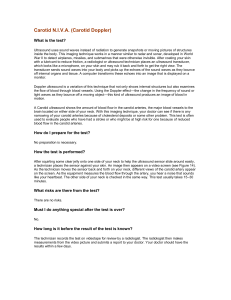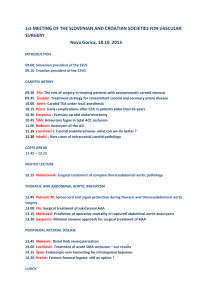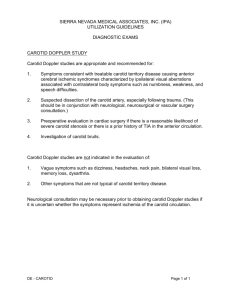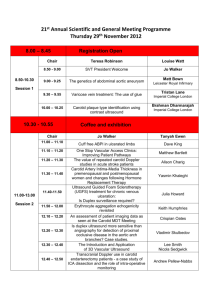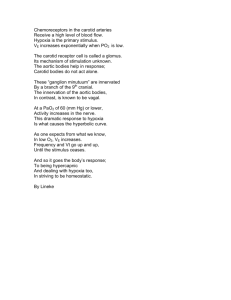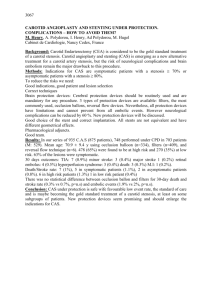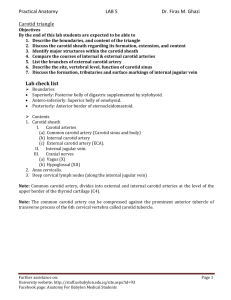Session 2 - Mosaiced.org
advertisement
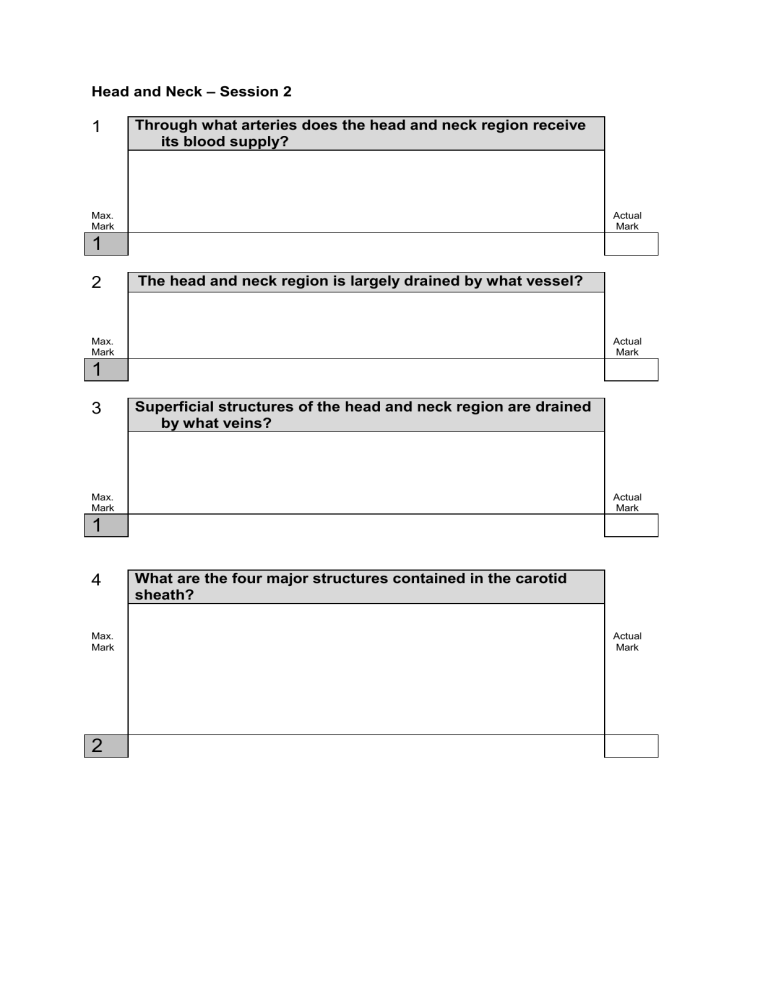
Head and Neck – Session 2 1 Through what arteries does the head and neck region receive its blood supply? Max. Mark Actual Mark 1 2 The head and neck region is largely drained by what vessel? Max. Mark Actual Mark 1 3 Superficial structures of the head and neck region are drained by what veins? Max. Mark Actual Mark 1 4 Max. Mark 2 What are the four major structures contained in the carotid sheath? Actual Mark 5 How is the carotid sheath derived? Max. Mark Actual Mark 4 6 Describe the thickness of the carotid sheath around the blood vessels it contains Max. Mark Actual Mark 1 7 Describe the position of the artery and the nerve contained in the carotid sheath with relation to the vein also contained in the carotid sheath Max. Mark Actual Mark 1 8 Max. Mark 1 What lies medially and posterior to the carotid sheath? Actual Mark 9 Describe where the right and left common carotid arteries arise. Max. Mark Actual Mark 2 10 Where do the common carotid arteries terminate? What landmark can be reliably used to identify this? Max. Mark Actual Mark 2 11 Max. Mark 4 Describe what happens when the common carotid arteries terminate. In particular what structures arise and what spinal level. Actual Mark 12 What are located in the Carotid Sinus? What condition can be alleviated through a gentle rubbing motion and what is the name of this motion? Max. Mark Actual Mark 2 13 What are located in the Carotid Body and what do they detect? Max. Mark Actual Mark 1 14 What is the Common Carotid Bifurcation a common site for and what clinical conditions could this lead to? Max. Mark Actual Mark 2 15 Max. Mark 3 How is the Internal Carotid Artery distinguished? What does it supply? How does it enter the skull? Actual Mark 16 Name all the branches of the External Carotid Artery Max. Mark Actual Mark 4 17 The External Carotid Artery divides within the substance of a salivary gland. What are the branches and what is the salivary gland? Max. Mark Actual Mark 2 18 During this division, it is accompanies by a nerve and a vein. Name both nerve and vein Max. Mark Actual Mark 1 19 Max. Mark 3 Describe where the Vertebral Arteries arise and their ascent, taking extra care to point out the exception). Also describe what they supply. Actual Mark 20 What is the Carotid Triangle a subdivision of? What structures can be accessed here surgically? Max. Mark Actual Mark 3 21 What are the boundaries of the Carotid Triangle? Max. Mark Actual Mark 3 22 What are the contents of the Carotid Triangle? Max. Mark Actual Mark 4 23 Max. Mark 1 What are the layers of the scalp? Actual Mark 24 Describe the blood supply to the scalp Max. Mark Actual Mark 4 25 Why can the scalps rich blood supply be a clinical problem? Max. Mark Actual Mark 2 26 A man has suffered a deep laceration to the head and is bleeding profusely. What aponeurosis has likely been damaged? Why are the opposing edges so distant? Max. Mark Actual Mark 2 27 Max. Mark 1 A medical student asks whether or not we should worry about the underlying bone necrotising. What do you say to the medical student? Actual Mark 28 What vessels are involved in venous drainage of the scalp? Max. Mark Actual Mark 4 29 What vessels unite at the medical angle of the eye? What vessel does this form? Where does this newly formed vessel drain into? Max. Mark Actual Mark 3 30 Max. Mark 4 What vessels do the veins of the scalp connect to? Via what? What is the clinical relevance of this? Actual Mark 31 What is the blood supply to the dura and the skull? Describe how this/these blood vessel(s) arise, starting from a branch of the common carotid artery. Max. Mark Actual Mark 3 32 What bony landmark does the artery that supplies the dura and skull run close to? Describe the clinical relevance of this. Max. Mark Actual Mark 3 33 What is a Craniotomy and how is bloody supply preserved during this procedure? Max. Mark Actual Mark 2 34 Max. Mark 4 Describe what a Dural Venous Sinus is and their function and where they form. Name 2 of the sinuses Actual Mark 35 What branch of the common carotid gives rise to most of the arteries that supply the face? What are the arteries that arise from the other branch? Max. Mark Actual Mark 2 36 Name the arteries that supply the face Max. Mark Actual Mark 4 37 Describe the venous drainage of the face. What do they mostly drain into? Max. Mark Actual Mark 3 38 Max. Mark 4 What is the Cavernous Sinus? What can also be found in the Cavernous Sinus? Actual Mark 39 Where do the Deep Facial Veins drain into? What is the clinical significance of this? Max. Mark Actual Mark 3 40 Which of the two branches of the Jugular Vein is easier to see? Therefore, which one is a better indicator of pressure in the heart? Specifically, what part of the heart? Max. Mark Actual Mark 3 41 What might an enlarged lymph node indicate? Max. Mark Actual Mark 1 42 Max. Mark 4 Name 8 of the regional lymph node groups Actual Mark 43 What are the Deep Cervical Nodes? Max. Mark Actual Mark 1 44 Name all 5 Terminal Lymph Groups Max. Mark Actual Mark 5 45 The efferent lymph vessels from the deep cervical nodes join to form what structures? Max. Mark Actual Mark 1 46 Describe the course of this structure of the left side and how it enters the venous system Max. Mark Actual Mark 3 47 Max. Mark 2 Describe the course of this structure of the left side and how it enters the venous system Actual Mark 49 Describe the Thoracic Duct Max. Mark Actual Mark 4 49 What does the thoracic duct empty into? Where? Max. Mark Actual Mark 2 50 What does the right lymphatic duct drain? Max. Mark Actual Mark 1 51 What does the right lymphatic duct drain into? What is this called? Max. Mark Actual Mark 2 52 Max. Mark 4 What is lymphadenopathy? What may it be caused by? Describe the difference textures due to the cause of the lymphadenopathy. Actual Mark 53 What is glandular fever caused by? Describe signs and symptoms Max. Mark Actual Mark 3 54 What is a lymphoma? Where does it originate? Max. Mark Actual Mark 3 55 What type of cancer causes 90% of Head and Neck cancer cases? What are risk factors? How do they present? How are they diagnoses? Max. Mark Actual Mark 4 56 Max. Mark 2 What can be done in the case of cervical metastases? What structures are involved? Actual Mark 57 What are the main functions of lymph nodes? Max. Mark Actual Mark 2 58 Describe the structure of a lymph node Max. Mark Actual Mark 4 59 Max. Mark 2 Describe what happens to B cells as they pass through the a lymph node if there is no stimulation Actual Mark 60 Describe what happens to B cells as they pass through the a lymph node if there is stimulation and their name changes Max. Mark Actual Mark 4 61 Describe the appearance of an activated B cell Max. Mark Actual Mark 2 62 What does the paracortex of a lymph node contain? Max. Mark Actual Mark 2 63 Max. Mark 3 Describe the contents of the medulla of a lymph node Actual Mark 64 Label this skull (Just what the coloured in sections are, not the arrows) Max. Mark Actual Mark 13 65 Max. Mark 2 What two portions make up the cranium? Actual Mark 66 Describe the organization of the calvaria bones Max. Mark Actual Mark 2 67 What do the bones of the cranial base articulate with? Max. Mark Actual Mark 3 68 Max. Mark 5 Fill in the boxes Actual Mark 69 Name all of the sites of weakness on a skull Max. Mark Actual Mark 5 70 Max. Mark 2 Describe some symptoms of a skull fracture Actual Mark 71 What type of cranial fracture is this? Describe its basic characteristics Max. Mark Actual Mark 3 72 Max. Mark 2 What type of cranial fracture is this? Describe its basic characteristics Actual Mark 73 What type of cranial fracture is this? Describe its basic characteristics Max. Mark Actual Mark 3 74 Max. Mark 2 What type of cranial fracture is this? Describe its basic characteristics Actual Mark 75 What are the two other type of cranial fracture? Describe their basic characteristics Max. Mark Actual Mark 4 76 Max. Mark 3 There is a junction where 4 bones meet and it is the thinnest part of the skull. What is its name and what bones form the junction? Actual Mark 77 Name all of the foramen of the Calvaria Max. Mark Actual Mark 7 78 Max. Mark 3 Name some common causes for facial fractures Actual Mark 79 Describe how one would acquire a Maxillofacial fracture Describe how one would acquire a Mandible neck fracture Max. Mark Actual Mark 2 80 What is a black eye? Max. Mark Actual Mark 1 81 What is a Mular flush? Max. Mark Actual Mark 2 82 Max. Mark 3 What is the name and function of C1? What is its shape? Actual Mark 83 Whats the name and function of C2? Describe some of its characteristics Max. Mark Actual Mark 6 84 Generally describe C3-C7 Max. Mark Actual Mark 2 85 Describe the special characteristic of C6 What may be compressed against it and why? Max. Mark Actual Mark 2 86 Max. Mark 2 What is the name of C7? What is it characterized by? Actual Mark 87 Why might a small cervical dislocation not damage the spinal cord? Max. Mark Actual Mark 1 88 Why might a fracture of the dens occur? What could it lead to? Max. Mark Actual Mark 5 89 When would the cervical region become hyperflexed? What could this lead to? Max. Mark Actual Mark 3 90 Max. Mark 6 When would the cervical region become hyperextended? What could this lead to? Actual Mark 91 Describe the pathophysiology of osteoarthritis of the cervical spine Max. Mark Actual Mark 2 92 What is a ‘Broken Neck’? What are the consequences of this? Where is it most common? Max. Mark Actual Mark 6 93 How might a Burst (Jefferson) Fracture occur? Max. Mark Actual Mark 1 94 How does a Hangman’s fracture occur? Max. Mark Actual Mark 1 /265
